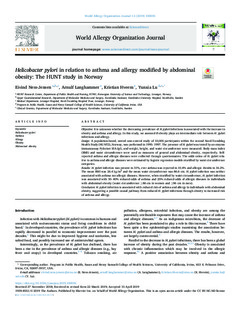| dc.contributor.author | Ness-Jensen, Eivind | |
| dc.contributor.author | Langhammer, Arnulf | |
| dc.contributor.author | Hveem, Kristian | |
| dc.contributor.author | Lu, Yunxia | |
| dc.date.accessioned | 2019-06-11T07:09:26Z | |
| dc.date.available | 2019-06-11T07:09:26Z | |
| dc.date.created | 2019-06-06T14:09:13Z | |
| dc.date.issued | 2019 | |
| dc.identifier.citation | World Allergy Organization Journal. 2019, 12 (5) | nb_NO |
| dc.identifier.issn | 1939-4551 | |
| dc.identifier.uri | http://hdl.handle.net/11250/2600402 | |
| dc.description.abstract | Objective
It is unknown whether the decreasing prevalence of H. pylori infections is associated with the increase in obesity and asthma and allergy. In this study, we assessed if obesity plays an intermediate role between H. pylori infections and allergy.
Design
A population-based, nested case-control study of 10,005 participants within the second Nord-Trøndelag Health Study (HUNT2), Norway, was performed in 1995–1997. The presence of H. pylori was tested by an enzyme immunoassay Pyloriset EIA-IgG, and weight, height, and waist circumference were measured. Body mass index (BMI) and waist circumference were used as measures of general and abdominal obesity, respectively. Self-reported asthma and allergic diseases were collected through questionnaires. The odds ratios of H. pylori relative to asthma and allergic diseases were estimated by logistic regression models stratified by waist circumference categories.
Results
H. pylori infection was present in 31%, ever asthma was reported in 10.4% and allergic rhinitis in 16.2%. The mean BMI was 26.4 kg/m2 and the mean waist circumference was 86.6 cm. H. pylori infection was neither associated with asthma nor allergic diseases. However, when stratified by waist circumference, H. pylori infection was associated with 30–40% reduced odds of asthma and 25% reduced odds of allergic diseases in individuals with abdominal obesity (waist circumference ≥86 cm in women and ≥96 cm in men).
Conclusion
H. pylori infection is associated with reduced risk of asthma and allergy in individuals with abdominal obesity, suggesting a possible causal pathway from reduced H. pylori infections through obesity to increased risk of asthma and allergy. | nb_NO |
| dc.language.iso | eng | nb_NO |
| dc.publisher | Elsevier | nb_NO |
| dc.rights | Attribution-NonCommercial-NoDerivatives 4.0 Internasjonal | * |
| dc.rights.uri | http://creativecommons.org/licenses/by-nc-nd/4.0/deed.no | * |
| dc.title | Helicobacter pylori in relation to asthma and allergy modified by abdominal obesity: The HUNT study in Norway | nb_NO |
| dc.type | Journal article | nb_NO |
| dc.type | Peer reviewed | nb_NO |
| dc.description.version | publishedVersion | nb_NO |
| dc.source.volume | 12 | nb_NO |
| dc.source.journal | World Allergy Organization Journal | nb_NO |
| dc.source.issue | 5 | nb_NO |
| dc.identifier.doi | 10.1016/j.waojou.2019.100035 | |
| dc.identifier.cristin | 1703196 | |
| dc.description.localcode | © 2019 The Authors. Published by Elsevier Inc. on behalf of World Allergy Organization. Open Access CC-BY-NC-ND. | nb_NO |
| cristin.unitcode | 194,65,20,15 | |
| cristin.unitname | Helseundersøkelsen i Nord-Trøndelag | |
| cristin.ispublished | true | |
| cristin.fulltext | original | |
| cristin.qualitycode | 1 | |

